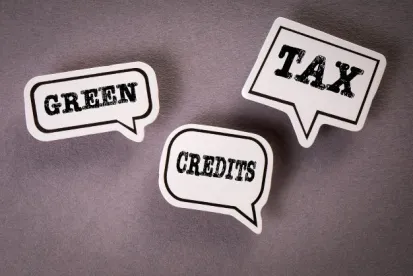The Internal Revenue Service (IRS) and Department of the Treasury earlier this month released final regulations (the “Low-Income Community Bonus Credit Rules”) relating to the low-income community bonus credit pursuant to Section 48(e) of the Internal Revenue Code of 1986, as amended (the “Code”).
Background to Low-Income Community Bonus Credits
The Inflation Reduction Act (the “Act”), passed just over one year ago, in August 2022, provided that wind and solar facilities, including any energy storage technology installed in connection with such facilities, that are less than 5 MW (AC) and placed in service in certain low-income communities may be eligible for an investment tax credit (ITC) increase of 10% or 20%. Wind and solar facilities claiming the production tax credit (PTC) under Section 45 of the Code are not eligible for the low-income community bonus credit.
In February 2023, the Department of Treasury and the IRS released Notice 2023-17 (the “Notice”), which provided a high-level overview of the low-income community bonus credit program (the “Program”) to be established under Section 48(e) of the Code and administered by the Department of Energy. The Notice provides a helpful summary of the four categories of communities that qualify for the Program. General information regarding the four categories may be found below.
|
Category # |
Type |
2023 Allocated Capacity |
Credit Increase |
|
1 |
Low-Income Community |
700 MW (DC) |
10% |
|
2 |
Indian land |
200 MW (DC) |
10% |
|
3 |
Qualified low-income residential building project |
200 MW (DC) |
20% |
|
4 |
Qualified low-income economic benefit project |
700 MW (DC) |
20% |
While the Notice provided helpful details regarding several notable features of the Program, including the: (i) 1.8 GW (DC) capacity limitation for 2023, (ii) estimated timing of when Program applications would begin to be accepted, and (iii) requirement that an allocation of capacity be awarded before the facility is placed in service, the Notice did not provide detail on the Program’s application process or the specific criteria that will be used to determine whether an allocation of capacity will be awarded. As of the date of publication, the applicant portal for the Program remains pending. The Low-Income Community Bonus Credit Rules provide significantly more detail for the Program.
The Low-Income Community Bonus Credit Rules
The Low-Income Community Bonus Credit Rules provide guidance on a number of issues relating to the potential increased credit amount under Section 48(e) of the Code and the Program, including additional detail regarding the increased credit categories, ownership criteria, and reporting requirements. Among the highlights:
In General:
-
Confirms facilities must be placed in service after an allocation of capacity is awarded, and the taxpayer must report the placed in service date.
-
Given the 5MW (AC) limit, clarifies that multiple solar or wind facilities or energy properties that are operated as part of a single project are aggregated and treated as a single facility or energy property under this section. The single project factors under IRS Notice 2018-59 apply.
-
Confirms that, similar to the energy community bonus credits, the Nameplate Capacity Test applies to the Low-Income Community Bonus Credits.
-
Explains that the capacity limit for each category may be reallocated to the extent one category is oversubscribed and another has excess capacity.
-
Provides that, once an allocation of capacity is awarded under the Program, the owner must report the placement in service date to the Department of Energy, which will then determine whether the facility remains eligible under the Program.
-
A facility will be disqualified and lose its allocation if one of the following occurs prior to or upon the facility being placed in service: (i) location of the facility changes, (ii) the net output increases to 5MW (AC) or more or the nameplate capacity decreases by the greater of 2 kW or 25% of the capacity limitation awarded (AC for wind, DC for solar), (iii) the facility can no longer satisfy the financial benefits requirement, if applicable, (iv) the eligible property that is part of the facility that received the capacity limitation award is not placed in service within four years after the date the applicant was notified of the award, or (v) the ownership criteria on which the award was based is no longer valid.
-
-
Provides for a new, separate, recapture threat under Section 48(e) of the Code if (during the five-year recapture period) any of the following occur after a facility is awarded an allocation of capacity under the Program and is confirmed eligible once placed in service: (i) if a Category 3 or 4 facility fails to provide financial benefits, (ii) if a Category 3 facility ceases to allocate the benefits equitably among the occupants, (iii) f a Category 4 facility ceases to provide at least 50% of the financial benefits of the electricity produced to qualifying households or fails to provide those households the required minimum 20% bill credit discount rate, (iv) if a Category 3 facility ceases to participate in a covered housing program or other affordable housing program, or (v) output increases to 5MW (AC) or more, unless as a result of new facility under 80/20 rule.
-
These apply even if the facility is not subject to recapture under Section 50(a) of the Code.
-
Reserved Capacity Limitation for Facilities Meeting Additional Selection Criteria:
-
Provides that at least 50% of the total capacity limitation in each facility category will be reserved for qualified facilities meeting certain additional selection criteria relating to either the owner or the geographic location of the facility. As a result the capacity limitations for each category set forth above are reduced by half for facilities not meeting the below criteria.
-
If the facility is owned by one of the following, such facility would be eligible for the 50% reserved capacity limitation: a tribal enterprise, an Alaska native corporation, a renewable energy cooperative, a qualified renewable energy company meeting certain characteristics, or a qualified tax-exempt entity. If one of the aforementioned entities is part of an ultimate partnership that owns the facility, such entity must own at least a 1% interest in each material item of partnership income, gain, loss deduction and credit and be a managing member at all times throughout the existence of the partnership for the partnership to be eligible for the reserved capacity limitation.
-
If the qualified facility is located in one of the following, such facility would be eligible for the 50% reserved capacity limitation : a Persistent Poverty County (at least 20% of residents have experience high rates of poverty over the past 30 years) or certain census tracts designated in the Climate and Economic Justice Screening Tool at the time of application
-
Category 1 Facilities:
-
Provides that there will be specific amounts of capacity limitation for eligible residential behind the meter facilities, including rooftop solar.
-
Behind the meter facilities must satisfy all of the following and must not meet the requirements for a Category 3 facility:
-
Must be connected with an electrical connection between the facility and the panelboard or sub-panelboard of the site where the facility is located,
-
Must be connected on the customer side of a utility service meter before it connects to the electricity grid, and
-
Its primary purpose is to provide electricity to the utility customer of the site where the facility is located.
-
-
The remaining capacity limitation is available for applicants with front of the meter facilities.
-
Category 3 Facilities
-
Clarifies various rules relating to the requirement that the financial benefits of the electricity produced by a Category 3 facility must be allocated equitably among the occupants of the dwelling units of the Qualified Residential Property, which can be a multi-family or single-family rental property.
-
Explains that at least 50% of the financial value of the energy produced by the facility must be equitably allocated to the occupants designated as low-income occupants under the covered housing program or other affordable housing program and provides the relevant calculation method to determine if this is satisfied.
-
-
While the Low-Income Community Bonus Credit Rules clarify that a signed benefits sharing agreement between the owner and building tenants is overly burdensome, the rules provide that the facility owner must prepare a Benefits Sharing Statement. Among other items, the Benefits Sharing Statement must include the calculation of the facility’s gross financial value, net financial value and the financial value required to be distributed to building occupants. In addition, the owner must formally notify the occupants of the Qualified Residential Property of the development of the facility and the planned distribution of benefits.
Category 4 Facilities
-
Clarifies that the Category 4 facility must satisfy all of the following:
-
Must serve multiple qualifying low-income households,
-
At least 50% of the facility’s total output in kW must be assigned to such qualifying low-income households, and
-
Each qualifying low-income household must be provided a bill credit discount rate, as defined below, of at least 20%, calculated on an annual basis.
-
-
Provides that, to establish that the above are satisfied, applicants must submit documentation upon placement in service that identifies each qualifying low-income household, the output from the facility allocated to each qualifying low-income household in kW, and the method of income verification used for each qualifying low-income household.
-
A qualifying low-income household low-income status is determined at the time the household enrolls in the subscription program. This does not need to be re-verified.
-
May use categorical eligibility, based on the qualifying low-income household’s participation in needs-based programs, or income verification methods through credit agencies and commercial data sources.
-





 />i
/>i

